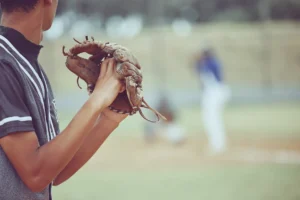Imagine you’re an athlete, standing on the field, ready to make the winning throw. However, you feel a sudden, sharp pain in your shoulder, and your throw falls short. Rotator cuff tears are not only painful but can also be a significant setback for athletes. In this blog post, we’ll take a closer look at rotator cuff tears, their symptoms, risks, and treatment options. We’ll also explore the importance of prevention and proper training to help you avoid this debilitating injury and keep you in the game. A common question that arises is, “can you throw with a torn rotator cuff?” I will address this concern as well.
Whether you’re a professional athlete or just enjoy the occasional game with friends, understanding rotator cuff tears, their causes, and how to prevent them is essential. By the end of this blog post, you’ll have the knowledge to make informed decisions about your shoulder health and ensure a successful and pain-free athletic career, including knowing the answer to “can you throw with a torn rotator cuff?”
Key Takeaways
- Take preventive steps to understand common causes of rotator cuff tears and seek medical attention for symptoms such as shoulder pain, weakness & range of motion issues.
- Understand the risks of throwing with a torn rotator cuff and take necessary precautions to safeguard your shoulder health.
- Learn from professional athletes’ experiences on seeking proper treatment & committing to personalized plans for successful recovery.
Understanding Rotator Cuff Tears
The shoulder is a complex ball and socket joint, consisting of the humeral head and the glenoid, which is part of the shoulder blade. The rotator cuff is crucial to shoulder stabilization and free movement of the humerus, which facilitates pitching and throwing. Shoulder joints are highly susceptible to rotator cuff tears due to their remarkable mobility, which can cause shoulder pain and discomfort. Overuse, frequent overhead motions, and repetitive overhead throwing in sports can all contribute to rotator cuff injuries.
Glenohumeral Internal Rotation Deficit (GIRD) is a common result of the extreme external rotation required to throw at high speeds, leading to stretching and loosening of the ligaments at the front of the shoulder and tightening of the soft tissues in the back of the shoulder, resulting in a loss of internal rotation. This condition can contribute to rotator cuff impingement and increase the risk of rotator cuff tears.
Being aware of the different kinds of rotator cuff tears and their usual causes can guide your decisions regarding shoulder health and encourage preventive actions.
Types of Rotator Cuff Tears
One of the most common shoulder injuries is a rotator cuff tear. It happens when one or more of the tendons that attach to the head of the humerus are torn, resulting in a lack of full attachment. There are two types of rotator cuff tears: acute and degenerative. Acute rotator cuff tears are the result of an unexpected injury, while degenerative tears are caused by prolonged wear and tear. The type of tear you have can affect your treatment options and recovery process.
Surgery may be necessary for athletes with acute rotator cuff tears, especially if they plan to resume intense activities post-recovery. On the other hand, degenerative rotator cuff tears are more common in individuals whose occupations require their arms to be overhead, such as painters and carpenters. In these cases, non-operative treatments like:
- Rest
- Anti-inflammatory medication
- Corticosteroid injections
- Physical therapy
may be recommended to manage pain and improve function.
Common Causes
Rotator cuff tears often result from the repetitive stress and strong force involved in sports activities. Throwing, lifting, and other sports activities can lead to repetitive stress and intense force, increasing the risk of rotator cuff injuries. Baseball players, in particular, can face a higher risk of rotator cuff tears due to the repetitive overhead throwing motions required in the sport.
Preventing rotator cuff tears in baseball players can be achieved by:
- Maintaining a balanced training regimen
- Avoiding overuse or acute injury
- Paying attention to any pain or discomfort felt while throwing
- Performing exercises that target the shoulder muscles
These steps can help your body listen, condition, and strengthen all shoulder muscle groups.
Grasping the usual causes of rotator cuff tears aids in taking preventive steps, thus promoting a successful athletic career.
Symptoms and Diagnosis
Identifying the symptoms of a rotator cuff injury is key to getting the right treatment and facilitating a smooth recovery. Pain in the shoulder and arm is indicative of a rotator cuff tear. Weakness when lifting or rotating the arm can also point to the same condition. If you’re
experiencing pain in your shoulder that worsens with activity or when at rest, it’s essential to consult a medical professional for proper diagnosis.
During a physical examination, doctors will assess the range of motion, strength, and stability of your shoulder and upper arm bone to help determine the extent of the injury and pinpoint your symptoms by placing your arm in different positions. Depending on the severity of your symptoms, imaging tests such as:
- X-rays
- MRI
- CT scans
- Ultrasounds
May be used to identify partial rotator cuff tear, rotator cuff tears, and rotator cuff tendon issues.
Prompt diagnosis and treatment of a rotator cuff tear can result in improved outcomes and speedier recovery.
Pain and Weakness
Persistent dull aches deep in the shoulder, difficulty sleeping due to discomfort, and arm weakness are tell-tale signs of a rotator cuff tear. Additionally, you may experience difficulty combing your hair or reaching behind your back, which can make carrying out everyday activities challenging. If you notice any of these symptoms, it’s essential to seek medical attention for proper diagnosis and treatment.
Early symptoms of rotator cuff tendinitis may include radiating pain from the front of the shoulder to the side of the arm, pain while performing throwing or other activities, and even pain while at rest. It’s essential to address these symptoms promptly to prevent further injury and alleviate pain and discomfort.
Range of Motion Limitations
A decrease in range of motion, particularly when attempting to lift the arm above the shoulder, can result from a rotator cuff tear. You may also experience pain and weakness when attempting to move the arm in certain directions. These limitations in range of motion can significantly impact your daily activities and athletic performance.
Seeking medical attention for proper diagnosis is essential, as a rotator cuff tear can be challenging to identify without the assistance of a medical professional. An orthopedic surgeon can carry out a physical examination and imaging tests to determine the severity of the injury and the most suitable course of treatment. Prompt diagnosis and treatment can help alleviate pain and restore mobility, allowing you to get back to your regular activities.
The Risks of Throwing with a Torn Rotator Cuff
Throwing with a torn rotator cuff might lead to severe damage and long-term effects. As a throwing athlete, it’s crucial to understand the risks associated with continuing to throw with a rotator cuff injury. Ignoring the pain and discomfort can lead to:
- Further injury
- Increased pain and inflammation
- Shoulder instability
- A decrease in throwing performance
Listening to your body and taking the necessary precautions to safeguard your shoulder is vital. If you’re experiencing pain or discomfort while throwing, consult a medical professional for a proper diagnosis and treatment plan. Continuing to throw with a torn rotator cuff without seeking medical advice can have serious consequences for your athletic performance and overall shoulder health.
Further Injury
Continuing to throw with shoulder instability could lead to further injury and a deterioration of the tear. The potential risks and consequences of throwing with a torn rotator cuff include:
- More pain and inflammation
- A worsening of the tear
- Shoulder instability
- Decreased throwing performance
It’s important to take the necessary precautions to protect your shoulder and prevent a shoulder injury or further damage.
If you suspect you have a torn rotator cuff, it’s crucial to seek medical attention for proper diagnosis and treatment. Attempting to continue throwing with a rotator cuff injury can exacerbate the problem and potentially lead to more severe injuries or even career-ending damage.
Long-term Consequences
Throwing with a torn rotator cuff can have long-term consequences, including decreased performance and possible career-ending damage. The long-term repercussions of throwing with a torn rotator cuff can be decreased performance and even career-ending damage, so it’s best to take the necessary precautions.
To ensure you’re preventing and training correctly for throwing with a torn rotator cuff, use proper throwing technique, strength and flexibility training, and seek medical advice for optimal results. Taking the necessary steps to protect your shoulder and maintain proper throwing mechanics can help you avoid the long-term consequences of throwing with a torn rotator cuff.
Treatment Options for Rotator Cuff Injuries
Upon encountering a rotator cuff injury, it is important to explore all available treatment options, including rotator cuff surgery, to decide the most suitable course of action for your particular situation. For some, non-surgical treatments may be sufficient, while others may require surgery to repair the damage and restore mobility.
Understanding the different treatment options for rotator cuff injuries can help you make an informed decision and ensure that you receive the most suitable treatment for your needs. By following a personalized treatment plan, you can work towards regaining your shoulder strength and mobility, allowing you to return to your regular activities and athletic performance.
Non-surgical Treatments
Non-surgical treatments can be effective for managing rotator cuff injuries and may include physical therapy, steroid injections, or PRP injections. For smaller tears or tendonitis, non-operative treatments such as rest, anti-inflammatory medication, corticosteroid injections, and physical therapy may be recommended.
By exploring non-surgical treatment options, you can work towards managing your rotator cuff injury and improving your shoulder function without the need for surgery.
Surgical Options
In some cases, surgery may be the best option to repair a rotator cuff tear and restore mobility. Surgical options for repairing rotator cuff tears include arthroscopy, a minimally invasive surgical procedure that uses a small camera to guide miniature surgical instruments into the shoulder joint for a more precise diagnosis and treatment.
The goal of surgery for rotator cuff tears is to help you regain movement and get back to your regular activities. It’s important to consult an orthopedic surgeon who specializes in sports medicine to discuss your specific situation and determine if surgery is the most suitable option for your rotator cuff injury.
Opting for surgery and adhering to a personalized rehabilitation plan can aid in regaining shoulder strength and mobility.
Prevention and Proper Training
Prevention and appropriate training play a significant role in preventing rotator cuff injuries and paving the way for a successful athletic career. By investing in specialized training that focuses on enhancing skills, strengthening the body, and improving techniques, you can become better equipped to withstand the pressures of the game and avoid rotator cuff tears.
Developing the correct technique and strength and flexibility can help minimize the chance of injury. Moreover, if an injury does occur, proper training can facilitate recovery and decrease the risk of further injury.
Whether you’re a professional athlete or just enjoy the occasional game with friends, incorporating prevention and proper training into your routine can help you avoid rotator cuff injuries and maintain optimal shoulder health.
Proper Throwing Technique
Mastering and employing correct throwing techniques is essential in minimizing the risk of rotator cuff injuries. Here are some tips to help you reduce the risk of injury and enhance your performance:
- Maintain 180° total shoulder range of motion
- Keep the elbow above the shoulder
- Keep the shoulder in line with the target
- Use the legs to generate power
By following these proper throwing mechanics and form, you can improve your throwing technique and reduce the risk of injury.
By practicing proper throwing technique, you can optimize your performance on the field and lower your risk of sustaining a rotator cuff injury. If you’re experiencing pain or discomfort while throwing, consult a medical professional or sports physician for guidance on improving your technique and addressing any underlying issues that may be contributing to your pain.
Strength and Flexibility Training
Integrating strength and flexibility training into your routine can bolster shoulder health and ward off rotator cuff tears. Strengthening and increasing flexibility in your rotator cuff muscles can be achieved through exercises like:
- Parallel Arm Shoulder Stretch
- Arm Circles
- Doorway Stretch
- External Rotation with Band
The advantages of strength and flexibility training for rotator cuff injuries are vast, such as improved shoulder strength and stability, increased range of motion, and decreased risk of injury. By practicing these exercises regularly, you can help protect your shoulder from injury and ensure that you’re in the best possible condition to excel in your chosen sport.
Summary
Throughout this blog post, we have explored the intricacies of rotator cuff tears, their symptoms, diagnosis, risks, treatment options, and prevention strategies. By understanding the anatomy of the shoulder, the role of the rotator cuff in throwing motions, and the common causes of rotator cuff injuries, we can take the necessary steps to protect our shoulders and maintain optimal athletic performance.
Whether you’re a professional athlete or simply enjoy staying active, prevention and proper training are essential for avoiding rotator cuff injuries and ensuring a successful athletic career. By incorporating strength and flexibility training, proper throwing techniques, and seeking medical advice when needed, you can safeguard your shoulder health and continue to excel in your chosen sport. Remember, your shoulder health is in your hands – take care of it, and it will take care of you.
Frequently Asked Questions
Q: Does it hurt to throw with a torn rotator cuff?
Throwing with a torn rotator cuff can cause severe pain, as it is one of the most common causes of shoulder pain in athletes. Overuse of the rotator cuff can weaken or damage it, leading to a painful experience while throwing.
Q: Can you still throw a ball with a torn rotator cuff?
Unfortunately, throwing a ball with a torn rotator cuff is not an option. The rotator cuff is essential for activities that involve overhead motions like pitching and throwing, so it’s important to keep it in good condition in order to stay healthy and injury-free.
Q: What are the common causes of rotator cuff tears in athletes?
Repetitive overhead throwing in sports and frequent overhead motions are common causes of rotator cuff tears in athletes.
Q: How can I tell if I have a rotator cuff tear?
If you are experiencing pain, weakness, or difficulty sleeping, it could be a sign of a rotator cuff tear. Seek medical advice from an orthopedic surgeon who specializes in sports medicine for proper diagnosis and treatment.
Q: What are the long-term consequences of throwing with a torn rotator cuff?
Throwing with a torn rotator cuff can lead to decreased performance, risk of re-injury, and even career-ending damage.




